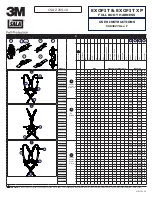
SINCE 1981
19
6.0 Problem Solving
The following is a guide for trouble shooting a heat exchanger that may not be performing
as expected. If more assistance is required please contact Graham personnel.
SYMPTOM : Fluid is leaking between two heat transfer plates and to the outside.
CAUSE: A gasket is loose or damaged.
SOLUTION: Mark or record which plate is leaking and open the heat exchanger in accordance
With section 5.1. Examine the plate in question to see if the gasket has become dislodged
from it’s groove or damaged. Reposition or replace the gasket as necessary.
CAUSE: The heat exchanger is not fully tightened.
SOLUTION: Count the number of heat transfer plates in the heat exchanger to verify the cor-
rect number. Tighten the heat exchanger in accordance with Section 5.2 until the leak stops.
CAUSE: A heat transfer plate has been damaged due to overightening or physical abuse.
SOLUTION: A damaged plate typically must be removed from the heat exchanger and either
repaired or replaced. Mark the leaking plate, open the heat exchanger in accordance with
Section 5.1, remove the plate and replace it with a new one.
If a replacement plate is not readily available, an option for making the unit operable is as
follows;
1) Remove the damaged plate.
2) If the damaged plate is a standard four hole plate, you should also remove the plate
immediately before or after it.
3) Close the heat exchanger in accordance with Section 5.2.
4) Due to the removal of some plates the heat exchanger must know be tightened to a re-
duced
dimension. Consult Graham engineers for a new appropriate dimension.
CAUSE: A heat transfer plate is misalligned in the heat exchanger.
SOLUTION: Mark and remove the leaking plate. Carefully repair the plate hanging or corner
allignment section of the plate so it alligns properly in the heat exchanger. If the plate still
hangs incorrectly in the heat exchanger it must be replaced with a new one. Close the heat
exchanger in accordance with section 5.2.
PLATE AND FrAME - HEAT ExCHANgErS









































